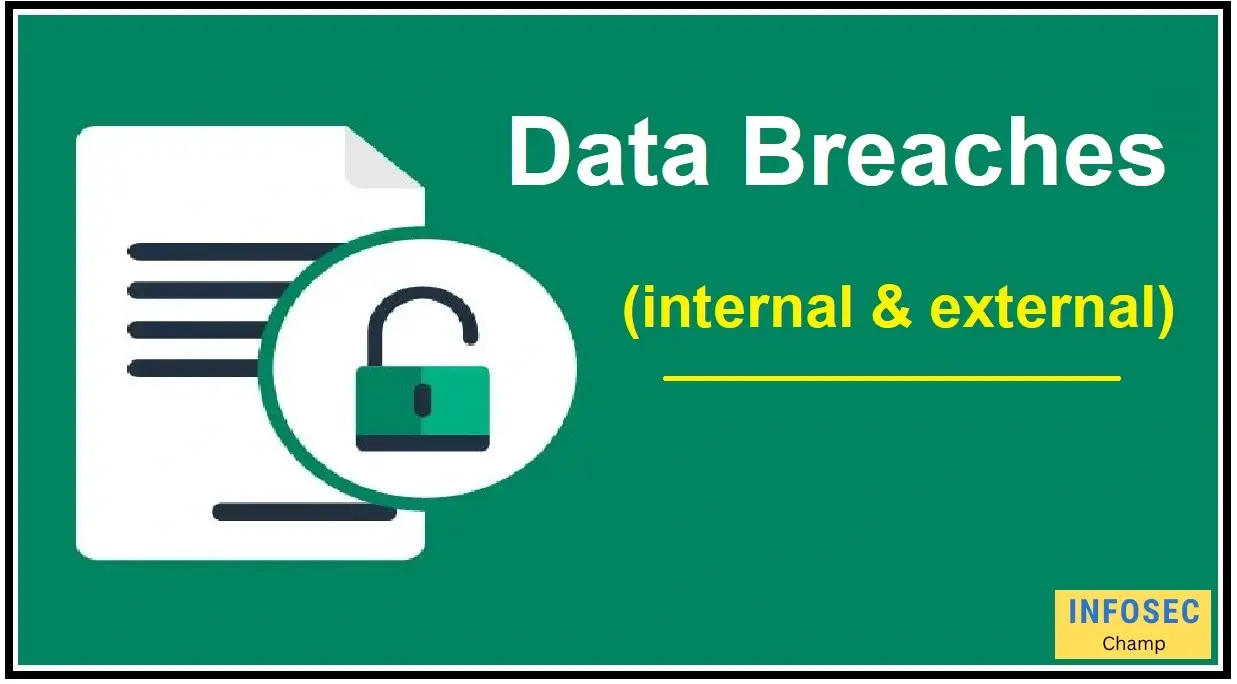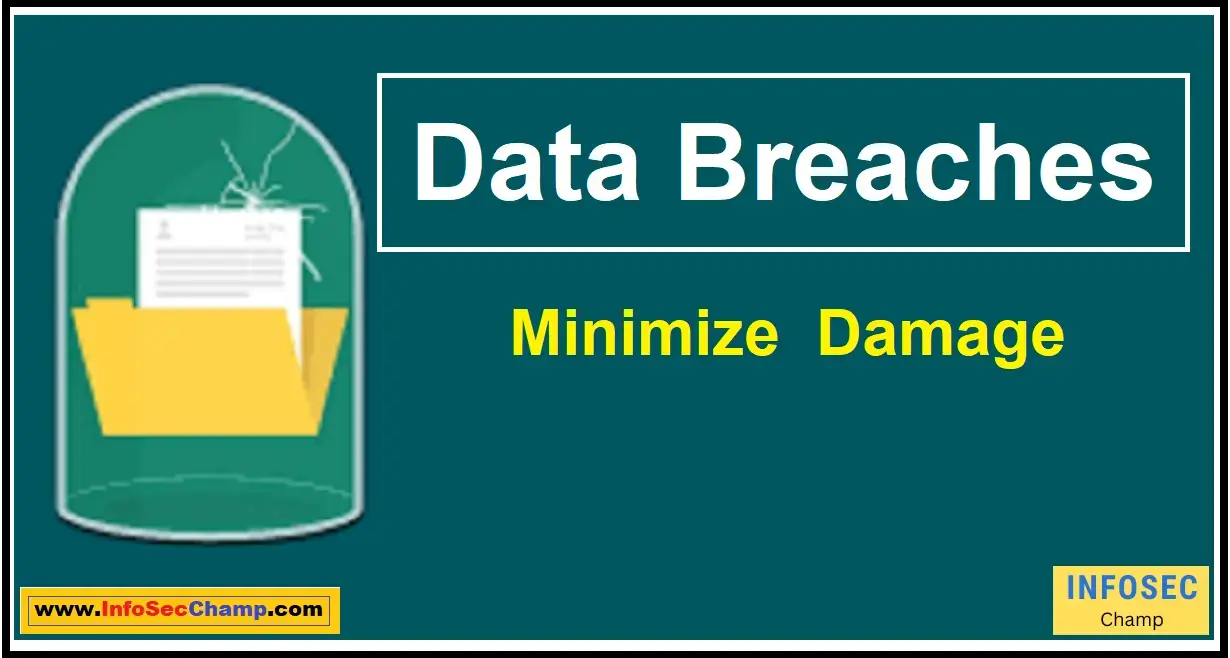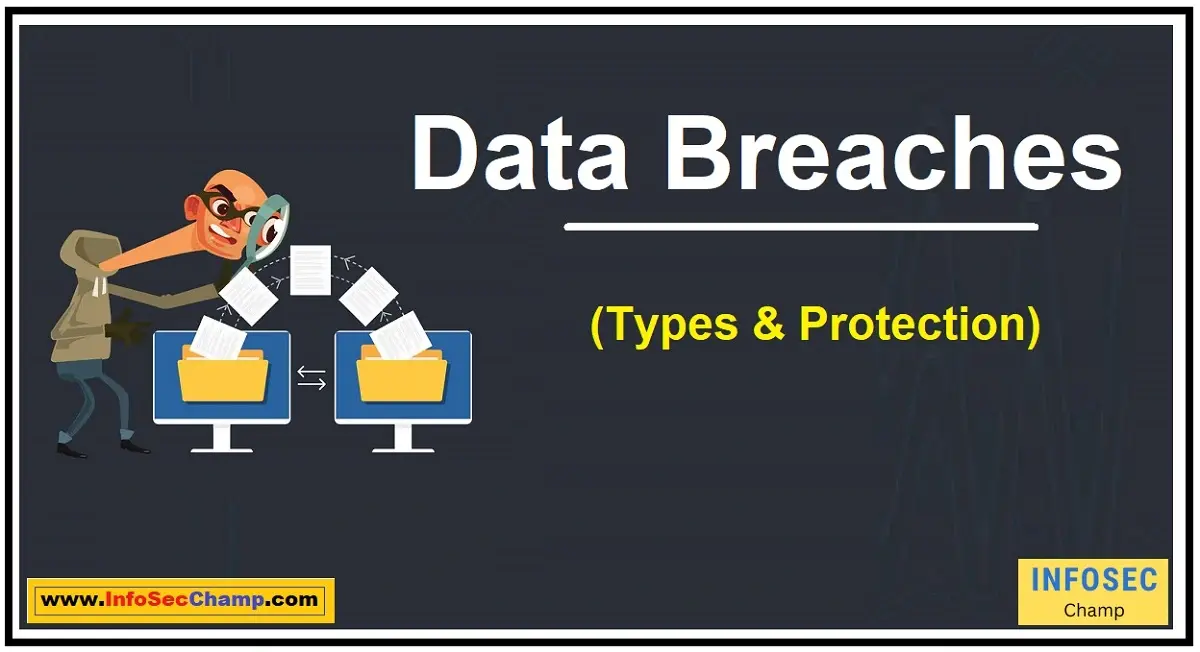Illegal access to or disclosure of sensitive data, such as personally identifiable information, financial information, or intellectual property, is referred to as a “data breach.” There are several different sorts of data breaches that can affect a company’s security posture, including:
- Phishing Attacks: Cybercriminals use the social engineering tactic of phishing to deceive people into disclosing critical information. It could take the shape of an email or website that appears authentic but is actually used to steal personal information.
- Malware Attacks: Software created specifically to damage or compromise computer systems is known as malware. It may take the shape of viruses, trojans, or ransomware, which can infect a system and either steal data or cause system damage.
- Insider threats: When workers or contractors with access to private information behave maliciously or unintentionally, the term “insider threat” is used. These kinds of violations might be intentional or inadvertent, and they can take place as a result of ignorance or inadequate training.
- Physical Theft: Data breaches may result from the physical theft of equipment like computers, smartphones, or hard drives. The data can be utilized for identity theft or other criminal activities if the devices include sensitive information that is not encrypted.
- Distributed Denial of Service (DDoS) Attacks: Attacks known as distributed denial of service (DDoS) include flooding a network or website with traffic, which can bring down the target. These assaults are typically carried out for political, extortionate, or ransom motives.
These types of data breaches can have serious effects on organizations, including monetary losses, legal responsibilities, and reputational harm. They might also result in a decline in consumer confidence and brand value.
Organizations can take a number of measures to reduce the risk of data breaches, such as:
- Establishing security rules and conducting routine security audits to find weaknesses
- To increase awareness of the many types of data breaches and recommended practices for prevention, cybersecurity training is provided to staff.
- Maintaining regular data backups and putting in place a disaster recovery strategy in the case of a breach
- To reduce the danger of physical theft or illegal access, make sure that data is encrypted both in transit and at rest.
- Putting in place a thorough incident response strategy that addresses locating, containing, and reducing the effects of data breaches
Organizations can lessen the potential impact on their security posture and reputation by being proactive and taking efforts to prevent various types of data breaches.
How do different types of data breaches occur and what techniques do cybercriminals use to exploit vulnerabilities?
Cybercriminals utilize a range of methods to exploit weaknesses, and data breaches can happen in a number of different ways. It’s crucial to comprehend how these assaults work in order to stop them and protect your data. Here are some of the most typical types of data breaches and the methods cybercriminals employ to do them:
- Phishing attacks: Phishing software is one of the most popular methods thieves employ to get private data. In these attacks, people are duped into disclosing their personal information via phony emails or websites.
- Malware attacks: Attacks with malware entail the installation of harmful software on a victim’s computer or other devices. Email attachments, malicious websites, and software flaws are all potential sources of this.
- Social engineering attacks: These types of attacks persuade people to reveal sensitive information. These attacks may use pretexting, baiting, or a quid pro quo, among other tactics.
- Insider threats: Insider dangers happen when someone with authorized access to sensitive data unintentionally or maliciously makes such data public. Negligence, a lack of training, or malevolent intent are all possible causes of this.
- Physical theft or loss: A physical device, such as a laptop, hard drive, or smartphone, may be stolen or lost in a physical theft or loss. If the device is not adequately secured or encrypted, it may lead to the loss of sensitive data.
Cybercriminals employ a variety of methods to exploit weaknesses in addition to these types of data breaches. These comprise:
- Exploiting software vulnerabilities
- Using weak or default passwords
- SQL injection attacks
- Cross-site scripting attacks
- Distributed denial of service (DDoS) attacks
- To prevent different types of data breaches, organizations can implement a range of security measures, including:
- Regular employee training on security best practices
- Strong password policies and multi-factor authentication
- Encryption of sensitive data
- Up-to-date software and hardware security measures
- Regular security audits and risk assessments
What are the most common sources of data breaches and how can they be mitigated?
Data breaches can happen from a variety of internal and external sources. Businesses must keep aware and take proactive measures to protect against data breaches since cybercriminals are continually creating new strategies and techniques to exploit flaws and access sensitive data. The followings are some of the most typical causes of data breaches and some mitigation techniques:
- Phishing Attacks: Cybercriminals frequently employ phishing emails to dupe people into disclosing sensitive information, such as login passwords or personal data. Offering employee education on how to spot phishing emails and how to avoid clicking on dubious links or downloading attachments is one way to mitigate risk.
- Putting in the place email security technologies to recognize and stop phishing emails
- To prevent unwanted access, enforce password regulations and two-factor authentication.
- Malware: Malware is a category of software that aims to harm, interfere with, or allow unauthorized access to a computer system. Email attachments, software downloads, and compromised websites are just a few of the ways malware can enter a system. Regularly upgrading antivirus and anti-malware software to guard against known threats is one of the mitigation measures.
- Limiting user rights to stop software installations that aren’t approved.
- Keeping an eye out for unexpected network activity or system slowdowns that might be suspicious.
- Insider Threats: An insider threat is when a user who has been given access to a system does so either knowingly or unknowingly by causing a data breach. Implementing access restrictions and monitoring to restrict access to sensitive data are examples of mitigation techniques.
- examining access rights for current employees and performing background checks on new hires.
- providing employees with information on the value of data security and the effects of insider threats.
- Lost or Stolen Devices: If sensitive data is kept on lost or stolen devices, such as laptops or cell phones, it may result in data breaches. Encrypting data on devices to prevent unauthorized access is one type of mitigation strategy.
- putting in a place remote wipe features to delete data in the event that a device is stolen or lost.
- reducing the amount of private data kept on portable devices.
Organizations may lower the risk of data breaches and safeguard sensitive information from thieves by putting these and other best practices into effect.

What are the key differences between internal and external data breaches?
Two distinct types of security incidents that might have an impact on a business are internal and external data breaches. Employees or other authorized users within the firm are responsible for internal data breaches, but external actors like hackers, malware, or other cyberattacks are responsible for external data breaches. Creating a successful cybersecurity plan requires an understanding of the major distinctions between internal and external data breaches.
Some of the main distinctions between internal and external data breaches are listed below:
| Key Differences | Internal Data Breaches | External Data Breaches |
| Source of the breach | Authorized personnel within the organization | External actors such as hackers, malware, or other forms of cyberattacks |
| Access to sensitive information | Internal actors typically have direct access to sensitive information | External actors may need to use advanced techniques to gain access to sensitive information |
| Motivation | Internal actors may have various motivations such as revenge, financial gain, or curiosity | External actors are often motivated by financial gain or to gain access to valuable data or intellectual property |
| Detection | Internal data breaches may be more difficult to detect as the actor is already authorized to access sensitive information | External data breaches are often easier to detect through monitoring and other security measures |
| Prevention | Internal data breaches can be prevented through access controls, employee training, and other internal security measures | External data breaches can be prevented through network security, firewalls, and other external security measures |
| Impact | Internal data breaches can have a significant impact on employee morale, trust, and productivity | External data breaches can have a significant impact on a business’s reputation, financial status, and customer trust |
In conclusion, while both internal and external data breaches can have serious repercussions for an organization, each type of breach might differ in terms of its origin, access to sensitive information, motive, detection, prevention, and impact. To reduce the risk of data breaches and safeguard sensitive information, a thorough security policy that tackles both internal and external threats is essential.
How can organizations identify and classify different types of data breaches?
Risks linked with data breaches are serious for organizations and can have negative effects on their finances, reputation, and legal standing. For the purpose of creating a security policy that can effectively reduce these risks, the capacity to recognize and categorize various types of data breaches is essential. Organizations can recognize and categorize various types of data breaches in the following ways:
- Data mapping: To identify sensitive data types and the corresponding risks, organizations should map out their data systems. By knowing this, it will be easier to prioritize response and preventive activities and identify the types of data breaches that could have the biggest effects on their business operations.
- Incident response planning: Having an incident response plan in place can assist firms in promptly identifying and categorizing various types of data breaches. The symptoms of various types of data breaches, such as social engineering assaults, malware, and insider threats, should be recognized by incident response teams.
- Security awareness training: Organizations should regularly perform security awareness training to inform staff about the many types of data breaches and how to spot and report them. Employee education on the most recent threats can assist to reduce the risks because employees are sometimes the first line of defense against data breaches.
- Network monitoring: Businesses can employ network monitoring solutions to spot many types of data breaches, including illegal access attempts and odd traffic patterns. Real-time warnings from these solutions can assist in immediately discovering and categorizing data breaches.
- Forensic analysis: In the event of a data breach, businesses should carry out a forensic investigation to ascertain the nature and extent of the incident. This can aid in determining the point of origin of the breach as well as the types of data that were stolen, enabling the business to take the necessary precautions to stop such breaches in the future.
In conclusion, enterprises must recognize and categorize the many types of data breaches in order to create a security plan that may effectively reduce the risks brought on by such incidents. Organizations can identify and categorize various types of data breaches, prioritize response efforts, and stop recurrent events by using data mapping, incident response planning, security awareness training, network monitoring, and forensic investigation.
What is the role of data encryption in protecting against different types of data breaches?
Data encryption is an essential tool for preventing unwanted access to sensitive data, particularly in light of various types of data breaches. Utilizing encryption technology can assist ensure that even if data is compromised, it remains inaccessible to readers and users. Here are some strategies for using data encryption to guard against various types of data breaches:
- Protects Data at Rest: Data saved on databases, hard discs, or other storage devices can be protected by encryption. This lessens the likelihood of data breaches brought on by lost, stolen, or compromised physical devices.
- Protects Data in Transit: Data encryption can aid in the protection of data being transmitted over a network or the internet. This can aid in preventing transmission-related data breaches, such as those brought on by man-in-the-middle attacks.
- Deters Hackers: Hackers are discouraged from attempting to steal sensitive information by data encryption. As easy targets are frequently preferred by hackers, data access is far more challenging when data is encrypted.
- Provides Compliance: Compliance with industry standards and laws frequently calls for encryption. In order to protect patient or financial information, laws like HIPAA and PCI-DSS mandate that some types of data be encrypted.
- Mitigates the Damage of Data Breaches: By making the data unreadable and useless to those who receive it, encryption can reduce the impact of a data breach.
In conclusion, securing sensitive data from many types of data breaches is essential thanks to data encryption. Data encryption is a crucial tool for preventing data breaches because it offers security for data while it is at rest and in transit as well as serving as a deterrent to hackers. Encryption can also lessen the effects of a data breach and assist maintain compliance with industry standards and regulations.

How can organizations effectively respond to different types of data breaches and minimize the damage?
Organizations must react swiftly and efficiently after a data breach in order to limit losses and safeguard their data and infrastructure. Various types of data breaches can be handled successfully in the following ways by organizations:
- Develop an incident response plan: Make a thorough incident response strategy that describes what to do in the event of a data breach. This plan should outline how to find the breach’s origin, minimize damage, notify those who were impacted, and take care of any legal or regulatory obligations.
- Establish a response team: Choose a group of people who will handle handling a data breach. IT experts, legal professionals, and communication specialists who can collaborate to manage the incident should be on this team.
- Conduct a risk assessment: Assess the hazards to the organization and the amount of harm the data breach has caused by doing a risk assessment. This will aid in properly allocating resources and prioritizing the response activities.
- Notify affected individuals: Individuals whose personal data has been compromised should be notified as quickly as feasible. Be open and honest about the breach and let people know what efforts are being done to address the issue.
- Secure systems and data: In order to stop future damage, secure systems and data right away. This could entail removing impacted systems from the network, resetting passwords, and putting new security measures in place.
- Review and update the organization’s security protocols: To stop future breaches, review and update the security protocols as needed.
- Cooperate with authorities: When necessary, cooperate with law enforcement and regulatory organizations. As a result, the source of the breach will be more easily found, and the business will be in full compliance with all legal and regulatory obligations.
Organizations may respond to various types of data breaches in an efficient manner and limit the harm to their systems, data, and reputation by taking the procedures outlined here. It’s crucial to keep in mind that prevention is always the best course of action, therefore businesses should take preventative measures to avoid data breaches altogether.
What are the most effective methods for preventing different types of data breaches?
For individuals and companies, data breaches can have detrimental financial, legal, and reputational effects. Fortunately, there are a number of efficient strategies for avoiding various types of data breaches:
- Employee training: Regularly educating staff members on cybersecurity threats and best practices for safeguarding sensitive data might help. This covers subjects including secure browsing practices, phishing prevention, and password management.
- Access Controls: Implementing access controls, such as role-based access control and multi-factor authentication, can assist reduce the number of people who have access to sensitive data. As a result, there is a lower chance of insider threats or illegal access.
- Encryption: By encrypting sensitive data, both in transit and at rest, thieves may have a harder time stealing or tampering with it. This entails using encrypted files, databases, and storage systems as well as secure communication protocols.
- Vulnerability Management: Vulnerability management can assist stop hackers from taking advantage of lapses in your security by routinely scanning systems and software for vulnerabilities and swiftly repairing them.
- Network segmentation: By restricting the extent of the assault, segmenting your network can help lessen the consequences of a data breach. This entails segregating sensitive systems and data from other network components.
- Incident Response Plan: Having a thorough incident response plan in place can help firms react to a data breach promptly and successfully. This has to have procedures for finding, containing, and lessening the effects of the breach.
- Regular Auditing: Regular security audits can assist you to find flaws, threats, and vulnerabilities in your security posture. This can provide guidance for continuing security enhancements and data breach prevention initiatives.
Organizations can greatly lower their risk of various types of data breaches by putting these precautions in place. Noting that no security solution is impenetrable, it’s crucial to periodically review and update your security plan in order to stay up with the changing threat landscape.
What are the potential financial and legal consequences of different types of data breaches?
For both individuals and companies, data breaches can have serious financial and legal repercussions. The following are some potential effects of a data breach in addition to the potential loss of important information:
Financial Losses:
- Revenue loss as a result of a damaged brand and diminished client confidence
- A rise in the price of data recovery, maintenance, and legal fees.
- Financial sanctions and fines for failing to adhere to data protection laws
- Responsibility for harms incurred by impacted people or entities
Legal Consequences:
- Potential legal actions brought by impacted parties or organizations seeking damages or compensation
- Regulatory fines and sanctions for breaking data protection regulations like the CCPA or GDPR
- Charges and prosecution in court for irresponsible or malicious behavior that led to the breach
Reputational Damage:
- Loss of client loyalty and trust as a result of the personal data breach
- Negative media coverage and publicity could damage the reputation and image of the brand
- Decreased employee morale and output as a result of how the scandal has affected the company’s reputation
It is significant to remember that the type and extent of the breach, the type of information that was compromised, and the relevant rules and regulations can all affect how severe the financial and legal repercussions are. To protect sensitive information, reduce risks, and act promptly and efficiently in the event of a breach, organizations should adopt preventive measures.
The following are some crucial tactics that might assist lessen the negative financial and legal effects of a data breach:
- Putting in place efficient access restrictions and security measures
- Frequent security inspections and risk evaluations
- Creating and evaluating an incident response strategy
- Educating staff members about data protection policies and practices
- Routinely evaluating and revising data protection rules and procedures
- Organizations can lower the risk of a data breach and lessen the financial and legal repercussions if it happens by using these techniques.

